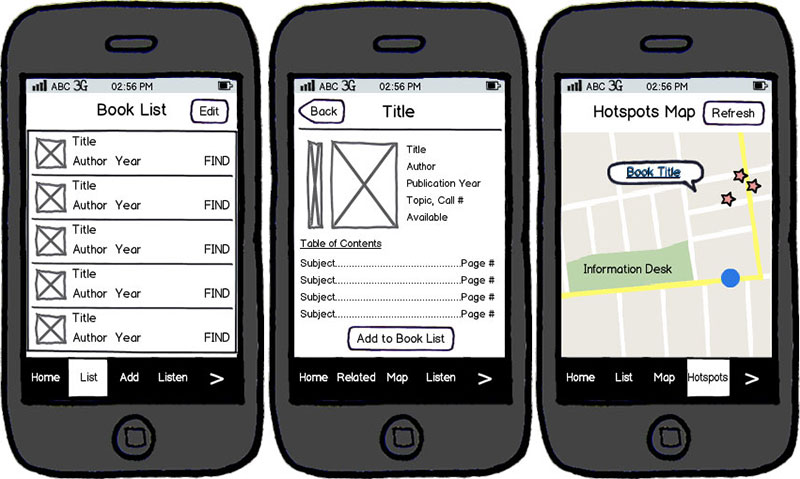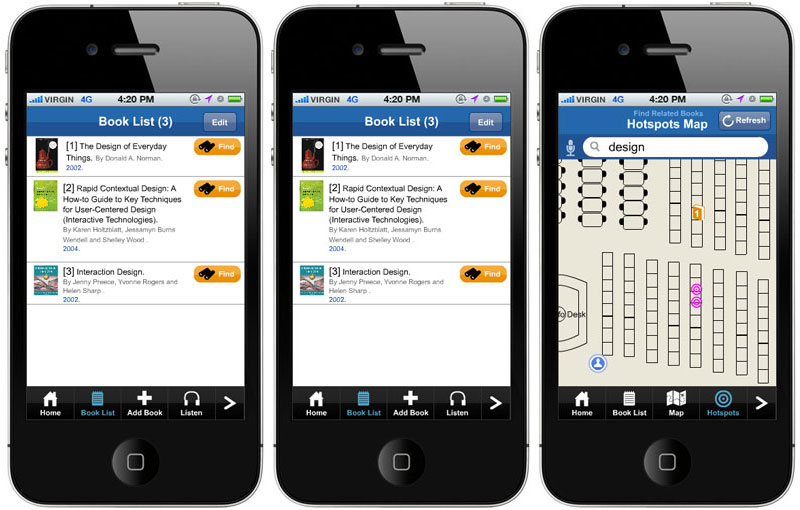Catalog Reader and Library Pathfinder (CLiP)
A mobile application that provides a seamless transition from searching for books on the catalog to physically locating books in the library. (Co-creator: Debaleena Chattopadhyay)
My Role
- Field research
- Wireframes
- Interface mockups
- Internal evaluation
- Interactive prototypes
- Usability tests

© 2012
This project was for a graduate school course that focused on research/analysis methods.
Purpose
Catalog Reader and Library Pathfinder (CLiP) is a mobile application that provides a seamless transition from searching for books on the catalog to physically locating books in the library. The primary goals of our application are to:
- Support the catalog search activity
- Improve the process for creating a personalized book list and finding a book's holding location
- Enhance the ability for gaining information about a book
Co-creator: Debaleena Chattopadhyay
Methodology
Contextual Inquiries
Contextual inquiries were conducted with library patrons at 2 public libraries and 1 academic library. We observed how library patrons use the library by following them around as apprentices, taking notes/pictures while we observed and asking them questions on their current thoughts and goals.
We found that patrons typically wrote down a list of interesting books they found in the catalog, including its title, author, publication date, and call number in order to locate the book in the library. A common difficulty among patrons was finding the book's exact holding location even though guidance signs were available throughout the library.
Observations also revealed that patrons briefly flip through the pages of a book and browse its table of contents to get a general idea of what the book is about in order to decide whether the book is relevant to their goal.
Below is the consolidated physical model:

Concept
The CLiP app provides more flexibility while the user is on-the-go in the library since initial observations revealed that patrons eventually leave the catalog station to physically find the books. CLiP includes four interaction types: instructing (i.e. find the book in the library), conversing (i.e. system asks user what elements of a book the user wants to listen to), manipulating (i.e. selecting books to add to the book list), and exploring (i.e. viewing where other related books are located in the library).
The user can search the catalog via CLiP app or catalog station and add any books of interest in a book list under his/her account. While sitting at a table or walking around the library, the user can also listen to the book details. He/She can use the book list to find directions to the books using an interactive map that indicates the user's current location relative to the location of the books.
Additionally, the user can choose to view any related books on the map that he/she did not add to the book list or add a book to the list. The relationships between the concepts will allow the user to better transition from searching for books on the catalog to physically locating books in the library, and also provide an alternative method book details that is important to the user's decision making process.
User flow:

Design
Low-Fidelity
Low-fidelity prototypes were created and used during internal evaluations to identify usability issues.

High-Fidelity
A high-fidelity dynamic prototype was developed based on the internal evaluation findings.

Evaluation
The high-fidelity dynamic prototype was used for the user evaluations. They did not find the listening feature to be necessary. However, they suggested additional features to include were:
- Add locations for vacant workstations in the library
- Book recommendation system
- Book ordering options

Overall, users found the library map, hotspots map, and book list to be a useful tool for library users since it is difficult to locate books in the library and these features help to improve that process.